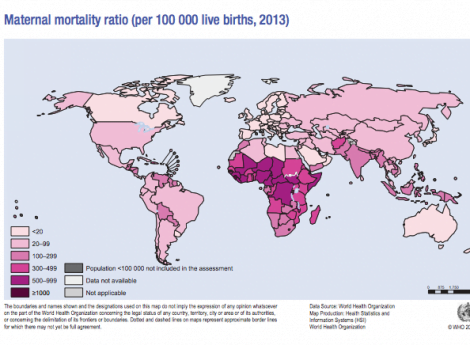Today’s map comes from the UN’s just-released 2013 report on maternal mortality around the world. First: the good news: the report finds that since 1990, maternal mortality has declined by 45%, from 523, 000 in 1990 to and estimated 289,000 women died from complications in childbirth in 2013. The bad news is that 289,000 is an awfully high number. Worse, it shows that the world is off track to reach the Millennium Development Goal of reducing maternal mortality by 75% by 2015.
Here’s where the problem is most acute.

40% of all maternal deaths in the world occurred in just two countries: India and Nigeria. But in terms of maternal mortality ratios, sub-saharan Africa is still very far behind other regions. Here are some highlights and lowlights from the report:
-Maternal mortality has declined: In 2013, the global maternal mortality ratio (MMR) was 210 maternal deaths per 100 000 live births, down from 380 maternal deaths per 100 000 live births in 1990 (a 45% reduction).
-Faster progress needed: The global reduction of MMR has accelerated, with a 3.5% annual decline from 2000-2013, as compared with 1.4% between 1990 and 2000. However, at current trends, most countries will not achieve the MDG target of a 75% reduction in MMR from 1990 to 2015. An average decline of 5.5% or more every year since 1990 is needed to meet the target on time.
-Ten countries carry most of the burden: Ten countries account for about 60% of global maternal deaths: India (50 000), Nigeria (40 000), Democratic Republic of the Congo (21 000), Ethiopia (13 000), Indonesia (8800), Pakistan (7900), United Republic of Tanzania (7900), Kenya (6300), China (5900) and Uganda (5900).
-Somalia and Chad have the highest risk: The highest lifetime risk of maternal death is in Somalia and Chad where women face a 1 in 18 and 1 in 15 lifetime risk respectively.
What are the main causes of death? A related WHO study of 60,000 maternal deaths found that 28% were caused or exacerbated by some pre-existing condition, like Malaria, AIDS, or diabetes; 27% of deaths were caused by post partum hemorrhaging; 11% by pregnancy induced high blood pressure (pre-eclampsia); and 11% by infections contracted during the birth.
The picture is bleak, but it’s important to remember that despite these unacceptably high numbers there has been significant progress over the years to make motherhood safer. The key goal now for policy makers is to accelerate this progress. This requires better pre and ante-natal care, better availability of drugs to treat hemorrhaging and bleeding, more skilled birth attendants, and access to modern contraception and safe abortion services. Until the time that these things are available and abundant to women in the developing world, maternal deaths will remain unacceptably high.
